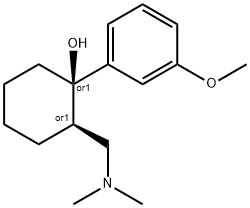
Трамадол
- английское имяTramadol
- CAS №27203-92-5
- CBNumberCB7104738
- ФормулаC16H25NO2
- мольный вес263.38
- EINECS248-319-6
- номер MDLMFCD00941467
- файл Mol27203-92-5.mol
| Температура плавления | 178-181 °C |
| Температура кипения | 406.62°C (rough estimate) |
| плотность | 0.9903 (rough estimate) |
| показатель преломления | 1.4909 (estimate) |
| температура хранения | 2-8°C |
| пка | 14.47±0.40(Predicted) |
| форма | solid |
| цвет | white to off-white |
| Справочник по базе данных CAS | 27203-92-5(CAS DataBase Reference) |
| FDA UNII | 39J1LGJ30J |
| Код УВД | N02AX02 |
| Справочник по химии NIST | Tramadol(27203-92-5) |
| Система регистрации веществ EPA | Cyclohexanol, 2-[(dimethylamino)methyl]-1-(3-methoxyphenyl)-, (1R,2R)-rel- (27203-92-5) |
| Коды опасности | Xn |
| Заявления о рисках | 22 |
| РИДАДР | UN 2811 6.1/PG 3 |
| WGK Германия | 2 |
| Банк данных об опасных веществах | 27203-92-5(Hazardous Substances Data) |
рисовальное письмо(GHS)
-
рисовальное письмо(GHS)

-
сигнальный язык
опасность
-
вредная бумага
H301:Токсично при проглатывании.
H336:Может вызывать сонливость или головокружение.
-
оператор предупредительных мер
P261:Избегать вдыхания пыли/ дыма/ газа/ тумана/ паров/ аэрозолей.
P264:После работы тщательно вымыть кожу.
P270:При использовании продукции не курить, не пить, не принимать пищу.
P271:Использовать только на открытом воздухе или в хорошо вентилируемом помещении.
P301+P310:ПРИ ПРОГЛАТЫВАНИИ: Немедленно обратиться за медицинской помощью. Прополоскать рот.
P304+P340:ПРИ ВДЫХАНИИ: Свежий воздух, покой.
P312:Обратиться за медицинской помощью при плохом самочувствии.
P403+P233:Хранить в хорошо вентилируемом месте в плотно закрытой/герметичной таре.
P405:Хранить в недоступном для посторонних месте.
P501:Удалить содержимое/ контейнер на утвержденных станциях утилизации отходов.
Трамадол химические свойства, назначение, производство
Химические свойства
Light Yellow OilИспользование
Tramadol is thought to produce analgesia by two distinct actions. First, it has agonist activity at the MOP and KOP receptors. Tramadol itself is a prodrug, with most of its analgesia mediated by a metabolite – O-desmethyltramadol – that has a 200-fold higher affinity for the MOP receptor. I t is metabolised by cytochrome P450 (CYP2D6 and CYP3A4), and its potency is therefore affected by a patient's CYP genetics, with rapid and poor metabolisers.S econd, it enhances the descending inhibitory systems in the spinal cord by inhibiting noradrenaline reuptake and releasing serotonin from nerve endings. It is available in immediate- and sustained-release oral preparations and for parenteral administration. I ts use is contraindicated in patients receiving monoamine oxidase inhibitors (MAOIs). Caution must also be exercised in hepatic impairment as its clearance is reduced to a much greater extent than morphine and related agents.
Общее описание
Tramadol (Ultram) is an analgesic agent with multiple mechanismsof action. It is a weak μ-agonist with approximately30% of the analgesic effect antagonized by the opioid antagonistnaloxone. Used at recommended doses, it has minimaleffects on respiratory rate, heart rate, blood pressure, or GItransit times. Structurally, tramadol resembles codeine with the B, D, and E ring removed. The manufacturer states thatpatients allergic to codeine should not receive tramadol, becausethey may be at increased risk for anaphylactic reactions. Tramadol is synthesized and marketed as the racemicmixture of two (the [2S, 3S] [-] and the [2R, 3R] [+]) of thefour possible enantiomers. The (+) enantiomer is about30 times more potent than the (—) enantiomer; however,racemic tramadol shows improved tolerability.Neurotransmitter reuptake inhibition is also responsible forsome of the analgesic activity with the (—) enantiomer primarilyresponsible for norepinephrine reuptake and the (+)enantiomer responsible for inhibiting serotonin reuptake. Like codeine, tramadol is O-demethylated viaCYP2D6 to a more potent opioid agonist having 200-foldhigher affinity for the opioid receptor than the parent compound.Tramadol was initially marketed as nonaddictive, anda 3-year follow up study showed that the abuse potential isvery low, but not zero. Most abusers of tramadol have abusedopioid drugs in the past. Both enantiomers of tramadoland the major O-demethylated metabolite are proconvulsive,and tramadol should not be used in patients with a lowseizurethreshold including patients with epilepsy.Механизм действия
Fentanyl is a μ agonist with approximately 80 times greater potency than morphine. Fentanyl has been used in combination with nitrous oxide for “ balanced” anesthesia and in combination with droperidol for “ neurolepalgesia.” The advantages of fentanyl over morphine for anesthetic procedures are its shorter duration of action (1–2 hours) and the fact that it does not cause histamine release on intravenous injection.Фармакокине?тика
The analgesic activity of tramadol is attributed to a synergistic effect caused by the opioid activity of the (+)-isomer and the neurotransmitter reuptake blocking effect of the (–)-isomer. The (+)-isomer possesses weak μ opioid agonist activity equivalent to approximately 1/3,800 that of morphine. The O-desmethyl metabolite (CYP2D6) of (±)-tramadol has improved μ opioid activity equivalent to 1/35 that of morphine. Affinity for both δ and κ receptors is improved. Despite its higher opioid potency, the contribution of O-desmethlytramedol to the overall analgesic effect has been questioned but not well studied. Individuals who lack CYP2D6 or are taking a CYP2D6 inhibitor have a reduced effect to tramadol. The fact that naloxone causes a decrease in the analgesic potency of tramadol argues strongly for an opioid component to the analgesic activity. (–)-T ramadol possesses only 1/20 the opioid activity of its (+)-isomer, but it has good activities for inhibition of norepinephrine (Ki = 0.78 μM) and serotonin (Ki = 0.99 μM) reuptake. Tramadol's neurotransmitter reuptake activity is approximately 1/20 that of imipramine, a tricyclic antidepressant agent that is used widely in pain management. Although none of the individual pharmacological activities of tramadol is impressive, they interact to give a synergistic analgesic effect that is clinically useful.Tramadol has been used in Europe since the 1980s and was introduced to the U.S. market in 1995. The drug is nonaddicting and, thus, is not a scheduled agent. In addition, tramadol does not cause respiratory depression or constipation.